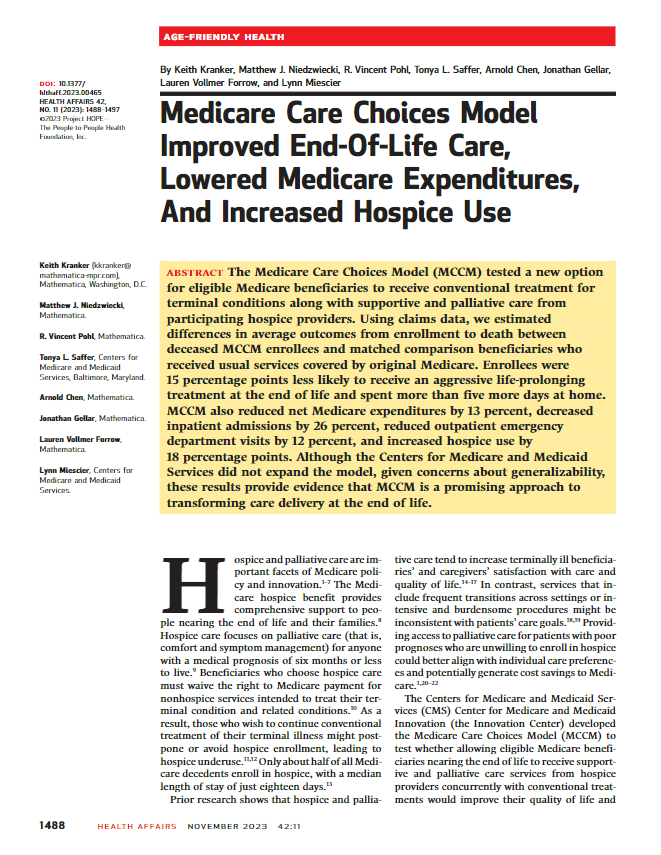Headline
Medicare model allowing concurrent coverage of hospice care and treatment improves end-of-life care and reduces total costs.
Context
Currently, Medicare Part A enrollees can only receive coverage for hospice care if they receive a medical prognosis of six months or less to live and they waive the rights to Medicare coverage for non-hospice services to treat their terminal illness and related conditions. This can cause some individuals to delay or avoid hospice and palliative care, despite research indicating that this form of care often increases patients’ and caregivers’ satisfaction with care and quality of life and may generate cost savings.
In 2016, the Centers for Medicare & Medicaid Services (CMS) implemented the Medicare Care Choices Model (MCCM). This model allowed eligible Medicare beneficiaries in the final stages of life to access supportive and palliative care services from hospice providers, alongside conventional treatments. To participate, beneficiaries had to meet typical criteria for hospice care, be referred by a provider, and have one of four qualifying terminal diagnoses: cancer, congestive heart failure, chronic obstructive pulmonary disease (COPD), or HIV/AIDS. This evaluation examines all six model years to assess MCCM’s impact on end-of-life treatment, patient costs, and hospice care utilization.
Findings
MCCM enrollees experienced significantly less intensive end-of-life treatment than a comparison group of similar Medicare beneficiaries not enrolled in MCCM. This difference is evident across measures of receiving aggressive life-prolonging procedures, acute hospitalizations, and the likelihood of dying in an inpatient facility. MCCM enrollees also exhibited a 13 percent lower per-person net Medicare expenditure once accounting for model expenditures. The 38 percent difference in inpatient expenditures between the two groups was a significant driver of the overall cost differences, despite greater hospice expenditures among MCCM enrollees. MCCM enrollees reported being much more likely to use hospice care (83 percent compared with 65 percent among the comparison group).
Takeaways
These findings suggest that increased access to hospice care can lead to patients receiving care that aligns more closely with the wishes of both patients and caregivers, along with potential overall cost savings. However, the lower-than-expected referrals to MCCM and high attrition rates among hospice providers raise questions about the generalizability of these findings. In response to these concerns, CMS chose not to expand the model, but these findings may offer valuable guidance for Medicare Advantage plans seeking to enhance access to hospice care.
Policy Insight
Two recently implemented CMS Innovation Center models, the Value Based Insurance Design (VBID) model and the Accountable Care Organization Realizing Equity, Access, and Community Health (ACO REACH) model, incorporate total-cost-of-care payment structures that allow for coverage of hospice and palliative care concurrently with conventional treatments. Despite the findings of this evaluation, the authors caution that participants in models like VBID and ACO REACH may be cautious about expanding access to these services beyond the relatively narrow patient population included in the MCM model, due to concerns about the potential risks of increased costs.




